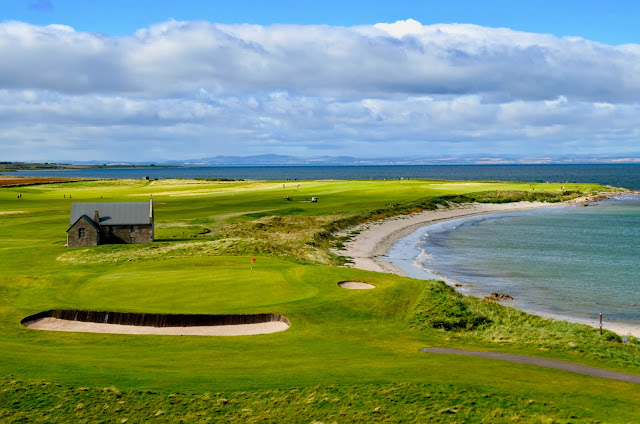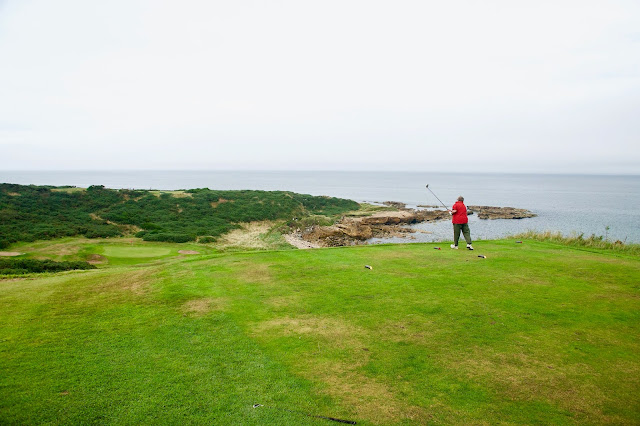This is the second part of the story. For the first part, see the previous post.
For those courses which did survive, some physical scars do remain. The flat holes at Powfoot are one reminder of what war did to golf courses. More dramatic, and of more concern to today’s players, are the remnants of German bombings. Stonehaven GC, south of Aberdeen, has a grass bunker in-play off the left side of the first fairway. The bunker is the result of a bomb dropped in August of 1940, by a German plane heading home from a mission. The hazard is now named, “Hitler’s Bunker.” Powfoot, also, left bomb damage in-play. The ninth hole is called “Crater” after the huge German bomb crater short of the green. Today, that bunker is a reminder of how hard it is to hit that particular green. Anne and I played Buckpool GC on the north coast of Scotland a couple of years after an unexploded ordinance was found near the green on one fairway.
 |
| Buckpool GC now has a new bunker. |
The MOD closed the course until they could explode the bomb. The course now has a new bunker more than 60 years in the making.
 |
| The flax mounding gives golfers interesting shots from Forfar GC's fairways. |
The rolling fairways of the first few holes at Forfar GC north of Dundee are the result of using fairways in World War I for drying netted flax. In November 1940 a RAF Spitfire fighter made a forced landing at Canmore GC. The landing and the hauling away of the plane did severe damage which can still be seen to several fairways. Perhaps the most devastation was done to the Cardross GC on the River Clyde north of Glasgow.
 |
| Cardross GC with its rebuilt 18th green and clubhouse. |
 |
| Cardross GC |
On May 6, 1941, the local villages and golf courses were bombed as part of a raid on the Glasgow ship works. While nearby Milngavie GC suffered damage to the 18th fairway and clubhouse, the Cardorss GC clubhouse was destroyed by incendiary devices, fairways and greens were hit several times, and several club members were killed in the blasts.
Besides playing around the bomb craters, avoiding the mines, and, at Aboyne GC, staying out the rough, which was planted with potatoes, golfers had to contend with other special war situations. Conditioning of the courses was much affected by the war. Many courses had to reduce their number of holes. Royal Dornoch and Boat of Garten both stopped maintenance on their farthest four holes because of a lack of grounds crew.
 |
| Boat of Garden GC in the Highlands |
After the MOD took much of the course, the remaining holes at Tenby became almost unplayable as moles and rabbits took over the course. Some courses, like Tulliallan in Scotland and St Deiniol in Wales, were maintained only because members were assigned specific holes to tend. At Panmure GC there weren’t enough members left keep the course playable,
 |
| Panmure GC |
but the Royal Scots Regiment stationed at nearby Barry Camp helped groom the course in exchange for free playing privileges. The most interesting example of course shortening was at Shiskine Golf and Tennis Club on Isle Arran.
 |
| Shiskine GC--4th Green, Drumadoon Point, and the Kilbrannan Sound. |
Six of the holes created by Willie Park & Sons, extending the course from nine to 18-holes, were permanently lost during World War I. Because of the lack of maintenance staff, the six Willie Park hill holes built on the side of Drumadoon Point were left to revert to their primitive state of gorse, heather, and bracken. After the war, the club chose not to reclaim the holes. Thus was born the world’s first permanent 12-hole course, a number which many visitors find to be just right.
Lack of staff and money created other maintenance headaches. For instance, because golf courses were only allotted ten gallons of petrol per month, fairways were seldom cut and rough became very deep. We know conditions for golfers during World War I were tough when Pyle & Kenfig GC (southern Wales)
 |
| Me enjoying Pyle and Kenfig GC's bunkers. |
club meeting minutes noted the “admirable sacrifice of the club in giving up bacon and ham” for the duration. The toughness of Scottish and Welsh golfers is not to be doubted. During competitions, or casual rounds, special war rules were in effect. One such rule said: “A player whose stroke is effected by the simultaneous explosion of a bomb or shell, or by machine-gun fire, may play another ball from the same place. Penalty, one stroke.” And another one: “In competitions, during gunfire or whilst bombs are falling, players may take cover without penalty for ceasing play.”
Golf equipment wasn’t left unaffected, either. In the First World War, importing hickory shafts for golf clubs was banned and club heads were often melted down for their metal. Golf balls became as valuable as gold to golfers. Since all rubber was needed for war related uses, new balls had almost disappeared by 1940. Players used balls until they were beaten, battered, and broken; then they were repainted and used some more. To lose a golf ball, even in thick gorse, was a crime. Searching for an hour or more was not unheard of in pursuit of a lost, playable ball. At Blairgowrie GC
 |
| Blairgowrie Rosemount GC |
two Glasgow Highlanders stationed nearby, stripped to the buff (in other words, took off their kilts) and waded into the Black Loch (part of the course) to look for lost balls which were then out of production. “They found them not by the scores, but by the hundreds.” [Cub Centenary Book] These were sold to local shopkeepers to resell. In one case early in the war years, a competition was held with a fresh turkey as first prize and six new Dunlop 65 balls as second prize. Everyone played for second!
During the war years, competitions became rarer or nonexistent. The Ryder Cup became the first victim of the Second World War when the 1939 matches in the US were canceled. The competitive spirit wasn’t dimmed, however, as shown by the Secretary of the British PGA’s cable to America: “When we have settled our differences and peace reigns, we will see that our team comes across to remove the Ryder Cup from your safekeeping.” The venerated Open Championship was suspended from 1940 to 1945, as it had been during the war years of 1915 to 1919. Those local competitions which were held, were often changed. The women’s competitions at Grantown-on- Spey, for instance, donated all entry fees to the local Red Cross. There were also many examples of professional and amateur golfers playing exhibitions to raise money for the war effort. In World War I, American superstar Bobby Jones (then only 16) played a match at North Berwick to raise money for the Red Cross. English professional Henry Cotton at about the same time played a match at Dumfries & County GC which raised £150 for the war effort—a small fortune for those days.
Not everything that happened as a result of the wars had a negative impact on the game. The war years brought more women to golf. They played more and their club status often changed from associate members to full members. One of the most dramatic changes to the game, which most would call positive, started at Powfoot GC in southern Scotland.
 |
| Powfoot GC |
The Sabbatarian tradition of no golf on Sunday was well entrenched in Scotland and Wales prior to 1914. Because of the war, Powfoot granted workers at the munition factory in nearby Gretna the right to play for free on their only day off--Sunday. Powfoot GC was one of the first to end Scotland’s Sabbaterian tradition, but other clubs in the area followed suit and the Sunday ban slowly lifted. Examples of financial gain by clubs during the war years are difficult to find, though some do exist. A prime example is St Deiniol GC (former Bangor GC) which went bankrupt in 1916.
 |
| Anne tees off at St Denial GC overlooking Bangor, Wales. |
During the second war the club profited from the large numbers of evacuees from London who moved to safer Wales. When the BBC offices were relocated to Bangor, alcohol sales in the clubhouse increased dramatically with, according to club minutes, “bar receipts in one of the war years touching a new high record level.”
It is said that in war there are no winners, only survivors. Golf in Scotland and Wales, for the most part, proved itself a survivor. As we play one of our favorite courses in the world, Shiskine Golf and Tennis Club, we marvel that its unique twelve hole layout is the result of a War-to-End-All-War.
NEXT: We visit England and the Cotsolds, in Better Days
















